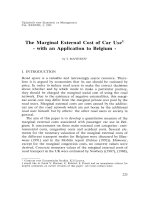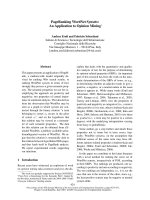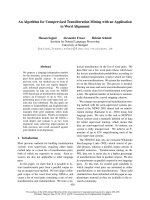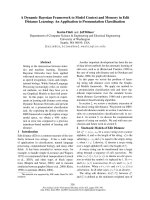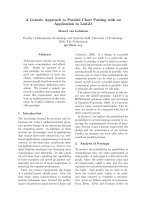An application to measure supply chain efficiency
Bạn đang xem bản rút gọn của tài liệu. Xem và tải ngay bản đầy đủ của tài liệu tại đây (1.23 MB, 192 trang )
MONTE CARLO DEA AND BUDGET ALLOCATION
FOR DATA COLLECTION: AN APPLICATION TO
MEASURE SUPPLY CHAIN EFFICIENCY
WONG WAI PENG
(MBA, Universiti Sains Malaysia)
A THESIS SUBMITTED
FOR THE DEGREE OF DOCTOR OF PHILOSOPHY
DEPARTMENT OF INDUSTRIAL & SYSTEMS
ENGINEERING
NATIONAL UNIVERSITY OF SINGAPORE
2008
ACKNOWLEDGEMENT
I would like to express my utmost gratitude to Dr. Jaruphongsa Wikrom, my
main supervisor and Associate Professor Lee Loo Hay, my co-supervisor for their
patience, constant encouragement, invaluable advice and excellent guidance
throughout the whole course of my research.
I would like to thank Professor Chen Chun Hung at George Mason University,
Professor Xie Min, Associate Professor Chew Ek Peng and Associate Professor Poh
Kim Leng at the National University of Singapore, who served on my oral
examination committee and provided me many invaluable and helpful comments on
my thesis research and writing. Many thanks to Dr. Zhou Peng and Dr. Teng Suyan
who helped me a lot during my PhD study. I also wish to thank Ms. Ow Lai Chun and
Mr. Victor Chew for their excellent administrative support pertaining to my PhD
study. I am also grateful to the members of Computing Laboratory, past and present,
for their friendship and help throughout my thesis research.
Last, but not least, I would like to thank my husband Theng Chye, my two
lovely kids Zhi Lyn and Zhi Jie, my parents and my mother in law for their constant
support and encouragement throughout the whole course of my study.
________________
Wong Wai Peng
i
SUMMARY
Supply chain efficiency measurement is a very difficult and challenging task. It
needs to take into account multiple performance measures related to the supply chain
members and it also requires huge and intensive data collection. In addition, the nature
of the data which are highly uncertain rendered many existing tools inoperable and
unable to provide an accurate efficiency score. Realizing the challenges in measuring
supply chain efficiency, this thesis focuses on some key methodological issues related
to applying data envelopment analysis (DEA) to measure supply chain efficiency in
stochastic environment.
This thesis is divided into three parts. In the first part, we present a relatively
comprehensive literature review of DEA and supply chain efficiency measurement,
which justifies the significance of the research work presented in this thesis. In the
second part, we focus on the development of a tool based on DEA and Monte Carlo to
measure supply chain efficiency in the stochastic environment. We develop a tentative
DEA supply chain model to address the efficiency measurement of the entire value
chain. Then, we enhance the model with Monte Carlo method to cater for efficiency
measurement in stochastic environment. The Monte Carlo DEA method is able to find
the distributions of the efficiency and tell where the true efficiency lies most of the
time. The information obtained is more meaningful and insightful for managers in
making decision compared to a discrete value of the efficiency.
In the third part of the thesis, we examine how to get a better estimate of the
efficiency score through budget allocation in data collection. The reason of addressing
the research problem within the context of the data collection is due to the fact that in
ii
reality the users need to collect data in order to calculate the efficiency score. In order
to solve the research problem, we develop two new methods which are the two-phase
gradient technique and the GA based technique. The GA and the two-phase gradient
techniques are effective and efficient in solving the budget allocation problem. In
addition, the second phase of the gradient technique, the GIS (Gradient Improvement
Stage) is flexible and can be incorporated with other existing techniques to further
improve the solutions.
The contributions of this research are three-folds. First, we provide an
alternative way to measure efficiency in stochastic environment, which is Monte Carlo
DEA. To show the usefulness of this method, we conduct an application study in
supply chain. Second, in the context where data collection is needed and expensive, we
provide a way on how to intelligently allocate the resources in data collection in order
to get a better estimation of the efficiency score. Third, we develop two new
techniques to solve this difficult problem.
This thesis provides the insights that it is important to conduct the data
collection intelligently (i.e. by using the two sophisticated techniques) in order to get a
better estimate of the efficiency and to achieve greater savings in the budget. Finally,
this thesis provides a potential methodological contribution in the operational research
field. It incorporates the use of simulation optimization techniques with DEA to obtain
a better and more meaningful result in efficiency measurement. Last but not least, the
methodology suggested in this research is widely applicable to other fields as well
other than supply chain in the area of efficiency measurement.
iii
TABLE OF CONTENTS
_____________________________________________________________________
ACKNOWLEDGEMENTS
SUMMARY i
TABLE OF CONTENTS iii
LIST OF TABLES vii
LIST OF FIGURES viii
ACRONYMS AND ABBREVIATIONS ix
CHAPTER 1: INTRODUCTION 1
1.1 Background to the Research 1
1.2 Difficulties in measuring supply chain efficiency 3
1.3 Research scope and objectives 5
1.4 Structure and organization of the thesis 6
CHAPTER 2: LITERATURE REVIEW 8
2.1 Introduction 8
2.2 Literature survey of supply chain efficiency measurement 8
2.3 Performance measures in supply chain 12
2.4 Traditional methods to measure supply chain efficiency 14
2.5 DEA 17
2.5.1 Basic DEA methodology 17
2.5.2 Main features and findings of past studies 21
2.5.2.1 Non-temporal effects 22
2.5.2.2 Temporal effects 26
2.5.2.3 Other features and findings 31
2.5.3 DEA in supply chain studies 32
2.5.3.1 Motivations of using DEA in supply chain 32
2.5.3.2 Past studies of DEA in supply chain 33
2.6 Issues in DEA 35
iv
2.7 Other miscellaneous 37
2.7.1 Monte Carlo method 37
2.7.2 Bayesian framework 39
2.7.3 OCBA (Optimal Computing Budget Allocation) 40
2.7.4 IPA (Infinitesimal Perturbation Analysis) 41
2.8 Concluding comments 42
CHAPTER 3: MEASURING SUPPLY CHAIN EFFICIENCY IN
STOCHASTIC ENVIRONMENT 44
3.1 Introduction 44
3.2 Background 44
3.3 Programming model for measuring supply chain efficiency 45
3.4 Efficiency measurement in stochastic environment 51
3.4.1 Common approach when applying DEA model in stochastic
environment 51
3.4.2 Monte Carlo DEA 52
3.5 An application study 55
3.5.1 The overall conceptual model for measuring supply chain
efficiency 55
3.5.2 Data used for the study 59
3.5.3 Setup of the experiments 60
3.5.4 Results and discussions 62
3.6 Conclusion and Managerial Implications 72
CHAPTER 4: BUDGET ALLOCATION FOR EFFECTIVE DATA
COLLECTION IN PREDICTION OF AN ACCURATE
EFFICIENCY SCORE 74
4.1 Introduction 74
4.2 Definition of accurate efficiency 76
4.3 Problem statement 77
4.4 Mathematical Programming Model 78
4.5 Summary 80
v
CHAPTER 5: TWO-PHASE GRADIENT TECHNIQUE 82
5.1 Background Information 82
5.2 Finding the gradient using IPA 83
5.2.1 1
st
stage (Perturbation generation) 84
5.2.2 2
nd
stage (Perturbation propagation) 86
5.2.3 3
rd
stage (Perturbation in performance) 90
5.3 First phase (Hill-climbing algorithm) 92
5.3.1 Negative Gradient 93
5.3.2 Round off 95
5.3.3 Step size 96
5.4 Second phase (Gradient Improvement Stage) 99
5.4.1 Overall concept 99
5.4.2 GIS algorithm 102
5.5 Summary 106
CHAPTER 6: GA TECHNIQUE AND COMBINATIONS OF OTHER
TECHNIQUES 107
6.1 Background information 107
6.2 Genetic Algorithm 108
6.3 Mechanisms 109
6.3.1 Integer encoding scheme 109
6.3.2 Feasibility 109
6.3.3 Fitness value 110
6.3.4 Population initialization 110
6.3.5 Selection and reproduction 111
6.3.6 Values of parameters and the termination condition 113
6.4 Issues 113
6.5 OCBA 114
6.5.1 OCBA-m Allocation Procedure 115
vi
6.6 Other Algorithms and Combination of the Techniques 121
6.7 Summary 124
CHAPTER 7: EXPERIMENTS SETUP, RESULTS AND DISCUSSIONS 125
7.1 Introduction 125
7.2 Parameter settings 126
7.3 Data used in the study 127
7.4 Results and discussion 131
7.4.1 Main insights 132
7.4.2 Performances comparison 134
7.5 Conclusion 142
CHAPTER 8: CONCLUSIONS AND FUTURE RESEARCH 144
8.1 Summary of results 144
8.2 Limitations of the research 147
8.3 Suggestions for future research 148
BIBLIOGRAPHY 149
APPENDICES
APPENDIX A: SUMMARY OF PAST LITERATURE SURVEYS 159
APPENDIX B: SUPPLEMENTARY RESULTS FOR THE MONTE
CARLO DEA APPLICATION STUDY 173
APPENDIX C: ALGORITHM FOR THE GA AND OTHER
TECHNIQUES 176
APPENDIX D: SUPPLEMENTARY TABLE AND FIGURE
FOR CHAPTER 7 179
vii
LIST OF TABLES
_____________________________________________________________________
Table 2.1: Classification of supply chain efficiency study literature 10
Table 3.1: Variables used in the DEA supply chain model 56
Table 3.2: Breakdown of the variables according to supply chain member 56
Table 3.3: Supply chain data 60
Table 3.4: Distribution of the random variables 61
Table 3.5: Deterministic efficiency score 62
Table 3.6: Target values for inputs, outputs and intermediate variables
for DMU 1 63
Table 3.7: Target benchmark for each DMU 64
Table 3.8: Ranking of DMUs 68
Table 3.9: Target peers and percentage of time for target benchmark for
each DMU 69
Table 3.10: Measure adjustments for DMU 7 71
Table 7.1: Simulation Setup 127
Table 7.2: Input/output variables used in the study 128
Table 7.3: Comparison of N and savings when D=5 133
Table 7.4: Comparison of N and savings when D=10 133
Table 7.5: Comparison of N and savings when D=15 134
Table 7.6: Comparison of RMSE and percentage improvement 135
Table 7.7: Comparison of RMSE of GA and GA+GIS and percentage
improvement 136
Table 7.8: Comparison of RMSE and percentage improvement with
incorporation of GIS 137
Table 7.9: Average CPU time 141
Table 7.10: Strengths and weaknesses of the techniques 142
viii
LIST OF FIGURES
_____________________________________________________________________
Figure 2.1: Proportion of publications 11
Figure 2.2: Breakdown of publications by types of journal 22
Figure 2.3: Breakdown of publications by research types 23
Figure 2.4: Breakdown of publications by application scheme 25
Figure 2.5: Trend of number of studies in DEA 27
Figure 2.6: Breakdown of publications by source of publication over time 27
Figure 2.7: Breakdown of publications by type of research over time 28
Figure 2.8: Breakdown of publications by application area over time 29
Figure 3.1: A simple chain relationship 45
Figure 3.2: Conceptual model for measuring supply chain efficiency in
stochastic environment 55
Figure 3.3: Boxplot of the Monte Carlo efficiency score 65
Figure 3.4: Excess distribution function for ‘High Efficiency’ DMUs 67
Figure 3.5: Excess distribution function for ‘Medium Efficiency’ DMUs 67
Figure 3.6: Excess distribution function for ‘Low Efficiency’ DMUs 68
Figure 6.1: A chromosome representation 109
Figure 6.2: Two-position crossover 112
Figure 6.3: Mutations 112
Figure 7.1: Experimental flow 130
Figure 7.2: Comparison between GA+GIS and Uniform 133
Figure 7.3: Comparison of MSE at different CV values 139
Figure 7.4: Comparison of MSE at different initial number of data 139
ix
ACRONYMS AND ABBREVIATIONS
_____________________________________________________________________
CCP Chance Constrained Programming
DEA Data Envelopment Analysis
GA Genetic Algorithm
GIS Gradient Improvement Stage
IPA Infinitesimal Perturbation Analysis
LP Linear Programming
MSE Mean Square Error
OCBA Optimal Computing Budget Allocation
OR Operational Research
LP Linear Programming
Chapter 1: Introduction
1
Chapter1
INTRODUCTION
This thesis contributes to some methodologies issues in applying simulation
optimization techniques and data envelopment analysis (DEA) to measure supply
chain performance, which could be helpful to analysts and decision makers in dealing
with stochastic environment. In this introductory chapter, some background
information is first provided, which is followed by the scope and objective of our
study. Finally, a summary of the contents of this thesis and its structure are presented.
1.1BackgroundInformation
Supply chain management has become one of the most frequently discussed
topics in the business literature. According to Simchi-Levi (2003), supply chain
management is a set of approaches utilized to efficiently integrate suppliers,
manufacturers, warehouses, and stores, so that merchandise is produced and
distributed at the right quantities, to the right locations, and at the right time, in order
to minimize system wide costs while satisfying service level requirements. Supply
chain is defined as a combinatorial system consisting of four processes namely plan,
source, make and deliver, whose constituent parts include material suppliers,
production facilities, distribution services and customers linked together via the feed
forward flow of materials and the feedback flow of information (Stevens, 1989;
Chapter 1: Introduction
2
Christopher, 1998). Effective management of an organization’s supply chains has
proven to be a very effective mechanism for providing prompt and reliable delivery of
high-quality products and services at the least cost. This is an essential corner stone for
the organizations to develop a sustainable competitive advantage and to remain at the
fore front of excellence in a level playing market field. To achieve an efficient supply
chain, performance evaluation of the entire supply chain is extremely important. This
means utilizing the combined resources of the supply chain members in the most
efficient way possible to provide competitive and cost-effective products and services.
Supply chain performance measurement needs to take into account the multiple
performance measures related to the supply chain members, the complex relationship
among the measures as well as the integration and coordination of the performances of
those members (Simchi-Levi, 2003). In addition, it requires huge and intensive data
collection, which is often not trivial. As such, measuring supply chain efficiency is a
very difficult and challenging task.
Ross (1998) mentioned that, even within large corporations such as Sears and
General Motors which had large supply chain systems, the supply chain performance
measurement systems were not in existence. Rao (2006) and Chou et al. (2005)
further highlighted that in view of the current level of complexity in performance
measurement, it requires more sophisticated tools to measure efficiency. The absence
of the performance measurement tool in supply chain is mainly due to the difficulties
in measuring the supply chain efficiency.
Chapter 1: Introduction
3
1.2Difficultiesinmeasuringsupplychainefficiency
Traditionally, the supply chain is usually managed as a series of simple,
compartmentalized business functions. The traditional supply chain was normally
driven by manufacturers who managed and controlled the pace at which products were
developed, manufactured and distributed (Steward, 1997). At such, measuring supply
chain efficiency during traditional times could be carried out fairly easily in a simple
manner. Generally, the efficiency is measured by taking the ratio of revenue over the
total supply chain operational costs. However, in recent years, new trends have
emerged in the efficiency measurement, where, customers have forced increasing
demands on manufacturers for quick order fulfilment and fast delivery. This has made
the supply chain efficiency difficult to be measured (Stewart, 1997). In addition to the
usual financial measures used to measure efficiency, the supply chain performance
now also needs to take into consideration other specific indicators such as the delivery
rate and percentage of order fulfilment. This measurement is further complicated by
the influence of manufacturing capacity and other influential operational constraints.
In view of the increasing performance measures in supply chain, not many
companies will know how to gauge the performance of their supply chain. The rise of
multiple performance measures has rendered the efficiency measurement task difficult
and unchallenging. In addition, supply chain efficiency measurement requires
knowing the performance of the overall chain rather than simply the performance of
the individual supply chain members. Each supply chain member has its own strategy
to achieve efficiency. However, what is best for one member may not work in favour
of another member. Sometimes, because of the possible conflicts between supply
chain members, one member’s inefficiency may be caused by another’s efficient
Chapter 1: Introduction
4
operations. For example, the supplier may increase its raw material price to enhance its
revenue and to achieve an efficient performance. This increased revenue means
increased cost to the manufacturer. Consequently, the manufacturer may become
inefficient unless it adjusts its current operating policy. Hence, measuring supply chain
performance needs to deal with the multiple performance measures related to the
supply chain members, and to integrate and coordinate the performance of those
members.
The measurement of supply chain efficiency is also greatly hampered by the
difficulties in obtaining a full set of accurate data. Supply chain performance
measurement requires data collection from the entire value chain which encompasses
the suppliers’ suppliers until the direct customer. Due to limited resources and time
availability, accurate data is difficult to be obtained. Most of the time, the data are
either incomplete or not accurate. The natures of these data which are highly uncertain
at present in many organizations render many existing tools inoperable and unsuitable
to be used for efficiency measurement. The uncertainties in the data could jeopardize
the results of the efficiency measurement and hence, the inaccurate efficiency score
obtained will not be useful to managers.
Hence, a tool to effectively measure the supply chain efficiency is greatly
needed. This is further supported by Yee and Tan (2004) who mentioned that in view
of the current level of complexity to address the supply chain problem, it involves
more sophisticated tools. Though, the measurement tool only serves as a stepping
stone for companies to achieve more strings of successes in the long term, the
foundation of measurement has to be laid out robustly by firstly developing a suitable
and useful tool for supply chain performance measurement. This tool will not only
Chapter 1: Introduction
5
perform the quantitative reasoning but will also provide insights to manager in the
qualitative perspective of strategic decision making.
1.3Researchscopeandobjectives
There are two main objectives of this thesis. First, it aims to address the
problem mentioned in supply chain performance measurement. It will provide an
analytical framework to measure the supply chain efficiency by considering the entire
value chain in the stochastic environment. This thesis develops a simple and efficient
tool, Monte Carlo Data Envelopment Analysis (DEA) to measure the supply chain
efficiency. This new tool will be able to find out the distribution as well as the
confidence interval for the true efficiency. These information are more meaningful and
insightful for managers in making decision compared to a discrete value of the
efficiency.
Secondly, this thesis aims to further examine how to get a better estimate of the
efficiency score when there are variations in the data. Existing stochastic DEA
method, which only provides a single mean value in the stochastic case, will not be
able to tell accurately where the true efficiency lies. This study will address this
problem within the context of data collection in the supply chain efficiency
measurement. The reason of addressing data collection is due to the fact that in real
industry, users would have to collect data in order to calculate the efficiency score.
Data collection is extremely difficult to be carried out in supply chain as it requires the
data from the entire value chain which encompasses from the suppliers until the direct
customers. Hence, this greatly suits the purpose to address how to collect the data
effectively. The prominent research question that will be addressed in this part of the
study is:
Chapter 1: Introduction
6
‘Given that the users have to collect data within a restricted budget to calculate the
efficiency score, what is the best way to allocate the budget for data collection so that
he/she can get a good estimate of the efficiency score?’
As there is no explicit model to address this question, this thesis will introduce few
methods based on the optimization simulation technique to solve the problem.
1.4StructureandOrganizationoftheThesis
This thesis focuses on the development of the methodology using DEA to
measure the supply chain efficiency when there are uncertainties in the data and to
improve the prediction of the efficiency through budget allocation for effective data
collection. In consists of eight chapters.
Chapter 2 presents a literature review in the supply chain efficiency
measurement, performance measures in supply chain, traditional methods used to
measure supply chain efficiency, DEA and its application in supply chain studies,
issues in DEA, and a brief review of other concepts or techniques which are applied in
this research. Chapter 3 presents the Monte-Carlo DEA based approach to measure the
supply chain efficiency. This approach serves as the basis for the second part of the
thesis.
Chapter 4 to 7 address the second part of the thesis which is to provide an
approach on determining how to collect data effectively so as to have a better
prediction of the efficiency score. Chapter 4 discusses some underlying concepts of
efficiency measurement in DEA, which path the way for the formulation of the
problem statement and the mathematical model of the research problem. Chapter 5-6
Chapter 1: Introduction
7
discusses the methodology on how to solve the model. The methodology comprised
of two main methods, which are the Two-Phase Gradient technique and the GA
technique. Chapter 5 discusses on the Two-Phase Gradient Technique, while Chapter 6
discusses on the GA technique and the combinations of the techniques with other
existing heuristic algorithms. Chapter 7 presents the results of the numerical
experiments. Finally, Chapter 8 summarizes the conclusions of this thesis and provides
suggestions for future research.
Chapter 2: Literature Review
8
Chapter2
LITERATUREREVIEW
1
2.1Introduction
This chapter discusses the literature review on the efficiency measurement of
supply chain, performance measures in supply chain, traditional methods used to
measure supply chain efficiency, DEA and its application in supply chain, issues in
DEA and other miscellaneous concepts which will be used in the research.
2.2Literaturesurveyofsupplychainefficiency
measurement
From the literature survey of supply chain efficiency measurement, we found
that the works can be mainly categorized into two types of studies, which are practical
and theoretical. The theoretical category covers the elements of measurement in
supply chain, which are namely the performance measures, concept and trends. On the
other hand, the practical aspect encompasses the modelling framework and empirical
case studies on supply chain. This classification is chosen based on the underlying
intention which is to address the distinctiveness between supply chains efficiency
measurement from other fields, and to identify potential research focus in this area
1
The work presented in this chapter has been published as Wong et al. (2008).
Chapter 2: Literature Review
9
through analyzing the imbalances in the past literature. In addition, the classification
used in this thesis has not been used in any of the past studies. Past surveys of supply
chain efficiency measurement have either focused on one particular attributes or
aspects for instance, purely on the performance measures, or emphasized mainly on a
particular type of industry.
Earlier efficiency studies in supply chain management covered types of
performance measures or practices and comparison of achievable performance levels.
Bogan and Callahan (2001) emphasized on internal performance metrics. Boyson et al.
(1999), Gilmour (1999) and Stewart (1995) stressed on the qualitative as well as the
quantitative performance measures in supply chain. Stewart (1997) and Lapide (2000)
addressed the needs to consider internal and external metrics in performance
improvement assessments. The concepts and trends in supply chain efficiency study
have also been largely explored since the late 19th century. Simatupang (2004)
highlighted the needs for an integrated supply chain performance measurement
system. Bowersox (1997) and Cox (1997) discussed the requirement of a novel type of
efficiency measurement system in supply chain due to the holistic approach of the
supply chain management. Gunasekaran (2001) highlighted that a novel type of
performance measurement system is needed for supply chain collaboration because the
chain members are concerned with both performance drivers and targets.
Mathematical and non mathematical approaches had been analyzed by
researchers to model supply chain efficiency, however the numbers are limited. Davis
(1993) and Arntzen et al. (1995) called for more research in the area of mathematical
modelling of the supply chain efficiency. Seiford (1999) highlighted that mathematical
Chapter 2: Literature Review
10
programming and associated statistical techniques to aid decision-making in supply
chain benchmarking is still lacking and more work can be carried out in this area.
Chopra and Meindl (2001) mentioned that the linkages of the mathematical models to
the strategic level of supply chain management is still lacking. Geary and Zonnenberg
(2000), Poirier (1999), Polese (2002), Simatupang (2004) addressed the modelling
frameworks for supply chain efficiency measurement. Basnet (2003) illustrated a case
study of efficiency measurement on supply chain practices in New Zealand
companies. Past literature indicates that empirical studies of supply chain efficiency
measurement and benchmarking are scarce. Table 2.1 depicts the contribution of
various researchers in each respective categories namely theoretical aspects (i.e.,
performance measure and integration of supply chain) and practical aspects (i.e.,
model, framework and case study) in supply chain efficiency studies.
Table 2.1: Classification of supply chain efficiency study literature
Period Authors Contribution
1995-1997 Boyson, Stewart, Gilmour Performance measure
Late 90s Bowersox, Simatupang,
Boyson, Kopcak, Stank,
Christopher, Ramdan,
Mentzer, Poirier
Integration supply chain /
interorganizational level
2001~2004 Van Landghen, Geary and
Zonnenberg, Poirier,
Polese, Simatupang
Model/ framework
2004 Basnet Case study
Figure 2.1 provides the statistics of the publications in supply chain benchmarking. As
can be seen in Figure 2.1, 60% of the publications deal with the theoretical aspects,
while 40% explain the practical aspects of supply chain efficiency studies.
Chapter 2: Literature Review
11
Performance
measure, 15%
Integration , 45%
Case study, 10%
Model/framework
, 30%
Performance measure
Integration
Model/framework
Case study
Figure 2.1: Proportion of publications
Appendix A (Table A.1-A.4) shows the summary of the literature on supply chain
efficiency studies, with details of the objectives of each study. The tables are
categorized according to the classification mentioned previously.
Past publications showed that supply chain efficiency study initiated from the
aspects of addressing performance measures and later moved into applying efficiency
measurement in an integrated perspective. Hence, this shows the growing trends in
supply chain efficiency studies. The present review of literature in this section has
identified certain issues which have not been satisfactorily addressed. These issues can
be regarded as inadequacies and they offer scope for further research and exploration.
Some of the issues identified are as follows:
1. Research in modelling and application of case study is scarce. Past researchers
developed theoretical frameworks to address integrated supply chain.
Mathematical modelling in supply chain efficiency study can be explored. The
Chapter 2: Literature Review
12
use of mathematical models can help to better gauge the performance and
provide clearer representation of the frameworks.
2. Tools used in supply chain efficiency measurement – Literature addressing the
sufficiency of the tools are lacking. The suitability of the tools in addressing
supply chain efficiency measurement in an integrated perspective needs to be
explored.
2.3PerformancemeasuresinSupplyChain
One important issue to address in supply chain efficiency study is to define
what are the performances measures because they drive the actions of managers and
the correct metrics are critical elements of a company’s performance. Performance
measures differ from field to field. Hence, this is one of the features that distinguish
supply chain efficiency study from general study.
Earlier conceptual developments of performance measurements in supply chain
have focused on cost-based performance measures because the cost metric is easily
understood and routinely welcomed by management (Ellram, 2002; Ballou et al.,
2000). Gradually, more researchers and practitioners seem to understand the shortfalls
of having just a unidimesional measure which is rather inflexible and lacks integration
with strategic focus. Hence, from the “cost” perspective, researchers began to put in
other quantitative as well as qualitative measures in supply chain efficiency
measurement. Beamon (1999) identified three types of measure, namely resources,
output and flexibility. Extending from this foundation, a framework for measuring the
Chapter 2: Literature Review
13
strategic, tactical and operational level of performance in supply chain was developed
(Gunasekaran, 2001).
The first universal performance measures that were used in supply chain
performance measurement were generated by Pittiglio, Rabin, Todd and McGrath,
widely known as the PRTM. It is a comprehensive set of fact-based performance
measures that were used to accurately describe a world-class supply chain of planning,
sourcing, making and delivering activities (Stewart, 1995). The measurement scheme
covers four areas of performance metrics which are identified as the keys to unlocking
supply chain excellence. They are delivery performance, flexibility and
responsiveness, logistics cost and asset management. This is the first known study that
objectively links best practices employed with relative quantitative performance
achievements. The PRTM’s concept of supply chain efficiency
measurement/benchmarking has been extended to become the supply chain operations
reference (SCOR) model by the Supply Chain Council (Stewart, 1997). The SCOR
then became the first cross-industry framework for evaluating and improving
enterprise-wide supply chain performance and management (integrated SCM). SCOR
is structured into four levels, based on a plan, source, make and deliver framework.
The model integrates the well-known concepts of business process re-engineering,
benchmarking and process measurement into a cross-functional framework, which
contains:
• Standard descriptions/terminology/definitions of management processes;
• A framework of relationships among the standard processes;
• Standard metrics to measure process performance;



